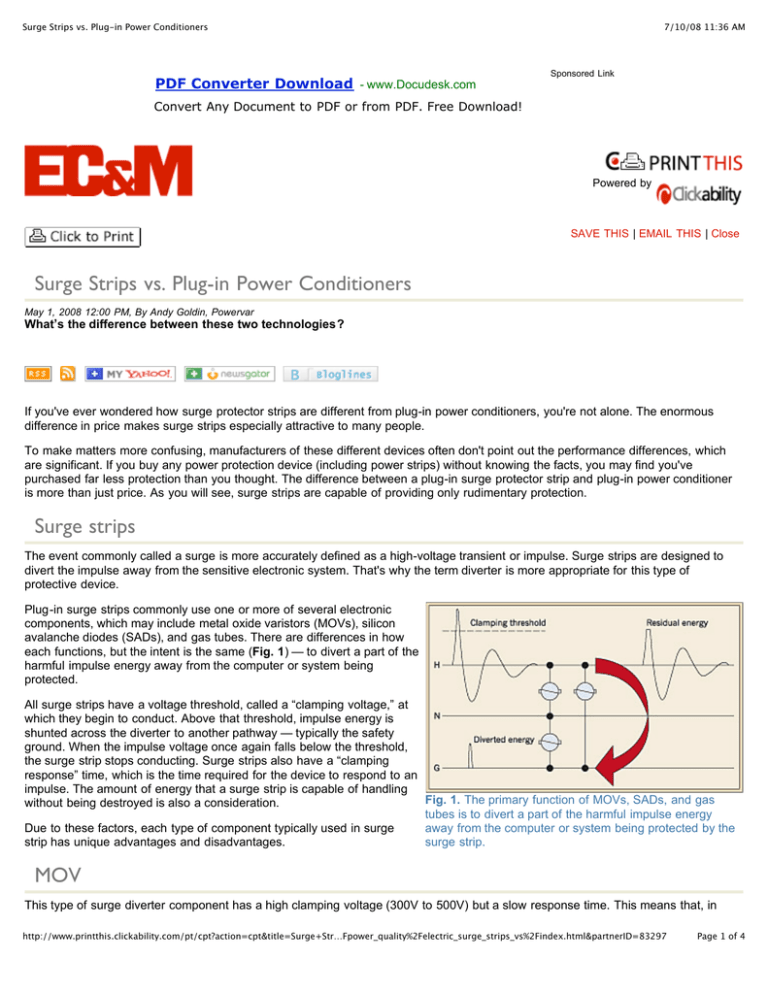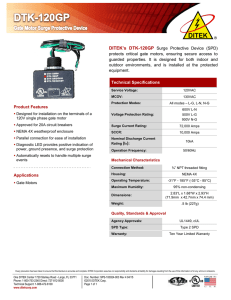
Surge Strips vs. Plug-in Power Conditioners
PDF Converter Download - www.Docudesk.com
7/10/08 11:36 AM
Sponsored Link
Convert Any Document to PDF or from PDF. Free Download!
Powered by
SAVE THIS | EMAIL THIS | Close
Surge Strips vs. Plug-in Power Conditioners
May 1, 2008 12:00 PM, By Andy Goldin, Powervar
What’s the difference between these two technologies?
If you've ever wondered how surge protector strips are different from plug-in power conditioners, you're not alone. The enormous
difference in price makes surge strips especially attractive to many people.
To make matters more confusing, manufacturers of these different devices often don't point out the performance differences, which
are significant. If you buy any power protection device (including power strips) without knowing the facts, you may find you've
purchased far less protection than you thought. The difference between a plug-in surge protector strip and plug-in power conditioner
is more than just price. As you will see, surge strips are capable of providing only rudimentary protection.
Surge strips
The event commonly called a surge is more accurately defined as a high-voltage transient or impulse. Surge strips are designed to
divert the impulse away from the sensitive electronic system. That's why the term diverter is more appropriate for this type of
protective device.
Plug-in surge strips commonly use one or more of several electronic
components, which may include metal oxide varistors (MOVs), silicon
avalanche diodes (SADs), and gas tubes. There are differences in how
each functions, but the intent is the same (Fig. 1) — to divert a part of the
harmful impulse energy away from the computer or system being
protected.
All surge strips have a voltage threshold, called a “clamping voltage,” at
which they begin to conduct. Above that threshold, impulse energy is
shunted across the diverter to another pathway — typically the safety
ground. When the impulse voltage once again falls below the threshold,
the surge strip stops conducting. Surge strips also have a “clamping
response” time, which is the time required for the device to respond to an
impulse. The amount of energy that a surge strip is capable of handling
Fig. 1. The primary function of MOVs, SADs, and gas
without being destroyed is also a consideration.
tubes is to divert a part of the harmful impulse energy
Due to these factors, each type of component typically used in surge
away from the computer or system being protected by the
strip has unique advantages and disadvantages.
surge strip.
MOV
This type of surge diverter component has a high clamping voltage (300V to 500V) but a slow response time. This means that, in
http://www.printthis.clickability.com/pt/cpt?action=cpt&title=Surge+Str…Fpower_quality%2Felectric_surge_strips_vs%2Findex.html&partnerID=83297
Page 1 of 4
Surge Strips vs. Plug-in Power Conditioners
7/10/08 11:36 AM
best-case scenarios, voltage impulses of less than 500V usually enter the computer system unimpeded. In addition, higher voltage
events with very fast rise times may pass by the MOV before it is able to respond. Although MOVs can handle a significant amount of
energy, they are physically degraded each time they clamp. This characteristic alters their future performance and ultimately leads to
physical failure.
SAD
The disadvantages of the MOV have led to the use of the SAD, either in conjunction with the MOV or in standalone applications.
Compared to MOVs, SADs have a faster response time and are not subject to the physical degradation that characterizes an MOV
design. The overall energy handling ability of the SAD, however, is not as high. An impulse that merely degrades an MOV may also
cause outright destruction of the SAD. To overcome this disadvantage, many surge strip manufacturers whose designs use
standalone SADs will parallel multiple SADs to increase the overall energy handling capability of the protector. Industry authorities
often vigorously debate the effectiveness of this design method.
Gas tubes
These devices have a high clamping voltage but are comparatively slow. However, they handle almost limitless amounts of energy.
Some surge strip designs use gas tubes as the final line of “brute force” protection to spare the lives of the other surge diverter
components in the presence of a catastrophic power line disturbance. In fact, many designs incorporate paralleled MOVs, SADs,
and/or gas tubes in an effort to improve performance by combining the relative strengths of each particular component.
Inherent limitations of surge strips
All surge strips have certain inherent limitations. We've already discussed some of these (clamping voltage, response time, energy
handling, etc.), but other factors are equally important.
The impulse shown in Fig. 2 is typical of the type of “ringing” transient
often found at the end of a long-branch circuit, where most computer
equipment is installed. This ringing is the result of the natural inductive
and capacitive reactance found in building wiring. These reactance
factors mean that the building wiring will oscillate at a unique frequency
when energized by surge current — much the same as a radio transmitter
oscillates when its output circuit is energized. While IEEE has found that
100 kHz is a typical ringing frequency for long branch transients, the
actual frequency will vary depending on the specific reactance of the
wiring. In fact, transient surges actually look more like a single (unipolar)
impulse than a ringing one nearer to the electrical service entrance of the
building (where little wiring reactance comes into play).
As part of the wiring system when installed, a surge strip interacts with its
Fig. 2. Graph of a typical type of “ringing” transient often
environment, and branch-circuit impedance becomes a factor in the
found at the end of a long branch circuit, where most
frequency response and clamping performance of the device. This
computer equipment is installed.
implication is important: Because branch-circuit impedance varies
throughout the system, the performance of the surge strip will vary as well. Furthermore, because these same characteristics affect
the frequency, wave shape, and rise time of an impulse at different places within the system, the performance of surge strips often
becomes unpredictable. Because the “garden variety” surge strip is subject to all of these limitations, it is realistically best suited for
limiting the worst part of a catastrophic electrical impulse.
Functional issues
There are two other functional factors of significant importance: longevity and what happens when a surge strip operates.
Because MOVs and SADs are both electronic components, both are subject to failure from a high-energy impulse. This is true
whether they're used singly or in combination. The probability of ultimate failure is the reason why so many surge strip products
incorporate an indicator light to signal when the protective elements are no longer functional. In most cases, surge strip components
are operating “naked” on the power line, and eventual failure is a foregone conclusion.
What happens when a surge strip operates is a key issue. Where does the surge go, and what are the affects of sending it there?
Answers to these questions, along with the inherent functional limitations of the surge strips, are the key differentiating factors
between surge strips and plug-in power conditioners.
http://www.printthis.clickability.com/pt/cpt?action=cpt&title=Surge+Str…Fpower_quality%2Felectric_surge_strips_vs%2Findex.html&partnerID=83297
Page 2 of 4
Surge Strips vs. Plug-in Power Conditioners
7/10/08 11:36 AM
Plug-in power conditioners
A common question is: “What is a power conditioner?” Simply stated, a power conditioner is any device that provides all the power
protection elements needed by the technology it's protecting. Although somewhat broad, this definition does focus our attention on the
fact that today's modern systems require different protection than their predecessors.
The linear power supplies used in older generation computers required voltage regulation. Today's' modern systems are powered by
switch mode power supplies (SMPS), which are technologically quite different. SMPS are immune to voltage regulation problems but
require protection from impulses, power line noise, and, most importantly, neutral-to-ground (N-G) noise voltage.
N-G noise voltage can be disruptive to the operation of a computer because the computer's microprocessor makes logic decisions
with reference to a clean, quiet ground. N-G noise voltages disturb this reference, possibly causing lockups, lost data, and
unexplainable system failures.
Surge strips function by diverting disturbance energy to ground as we
saw in Fig. 1. In the process, they convert a destructive disturbance into
a disruptive one. Meanwhile, because the surge strip allows substantial
energy to pass on to the computer, the computer itself may still be
degraded by the residual surge energy. This explains why in so many
instances a user experiencing catastrophic hardware failure will install a
surge strip only to find that hardware failures (while fewer) still occur —
and that the system now behaves unreliably at times.
A plug-in power conditioner will incorporate three elements: A) a surge
diverter; B) an isolation transformer; and C) a power line noise filter (Fig.
3).
This “ABC” approach provides
several operational benefits.
Isolation transformers permit the
bonding of neutral to ground on
the transformer secondary. (See
The Elegance of
Transformers on page 28.)
Permitted by the NEC, per Sec.
250.20D, this “separately
derived system” eliminates N-G
voltages. This means that the
surge diverter within the power
conditioner can now divert
surge energy to ground without
creating an N-G disturbance in
the process. Because noise
filters also function by diverting
electromagnetic interference
and radio frequency
interference to ground in the
same manner, combining them
with an isolation transformer
also enhances their
performance.
Fig. 3. An “ABC”-style plug-in power conditioner
incorporates a surge diverter, isolation transformer, and
power line noise filter.
Fig. 4. The result of a surge strip
responding to a 1,000V impulse injected
between phase and neutral on its input.
Note the amount of impulse energy
passed by the surge diverter to its
output as well as the amount diverted to
ground.
Due to the limitations already discussed, surge strips can only limit transient impulses to levels of hundreds of volts. Figure 4
illustrates the result of a surge strip responding to a 1,000V impulse injected between phase and neutral on its input. Note how much
of the impulse is passed by the surge strip to its output and how much is diverted to ground.
A transformer-based (“ABC” style) plug-in power conditioner allows far less of the disturbance to reach the critical load. Figure 5
shows the same 1,000V impulse injected between phase and neutral at the input to an “ABC”-style plug-in power conditioner. Note
that the phase-to-neutral impulse (normal mode) is attenuated to less than 10V while less than 0.5V appears between neutral and
ground at the output.
http://www.printthis.clickability.com/pt/cpt?action=cpt&title=Surge+Str…Fpower_quality%2Felectric_surge_strips_vs%2Findex.html&partnerID=83297
Page 3 of 4
Surge Strips vs. Plug-in Power Conditioners
7/10/08 11:36 AM
The bottom-line
Power line disturbances can destroy, degrade, and disrupt electronic systems. Plug-in surge
strips are only capable of reducing surge energy — not eliminating it. Plug-in power
conditioners that include a surge diverter, isolation transformer, and power line noise filter in
their design can eliminate system destruction, component degradation, and operation
disruption by exhibiting much better control over surge voltages.
Remember that the performance of naked surge strip components in an electrical system is
unpredictable. The performance of plug-in power conditioners with an isolation transformer
in the same electrical system is predictable and repeatable. Surge strips create N-G voltage.
Plug-in power conditioners eliminate it.
Goldin is engineering manager for Powervar, Inc., Waukegan, Ill. He can be reached
atandyg@powervar.com.
Sidebar: The Elegance of Transformers
Fig. 5. A 1,000V impulse injected
between phase and neutral at the input
to an “ABC”-style plug-in power
Transformers are an elegant power quality tool. Their secret is in their unchanging
secondary impedance. Surge diverters interact with the impedance of the building wiring in a conditioner. Note that the phase-toway that makes their performance unpredictable. Noise filters suffer similar fates. However, neutral impulse (normal mode) is
attenuated to less than 10V while less
when designed to match the fixed secondary impedance of an isolation transformer, their
than 0.5V appears between neutral and
performance is not only predictable, but also controllable and repeatable by design.
ground at the output.
Find this article at:
http://www.ecmweb.com/power_quality/electric_surge_strips_vs/index.html
SAVE THIS | EMAIL THIS | Close
Check the box to include the list of links referenced in the article.
Copyright © Primedia Magazines, Inc. All rights reserved.
http://www.printthis.clickability.com/pt/cpt?action=cpt&title=Surge+Str…Fpower_quality%2Felectric_surge_strips_vs%2Findex.html&partnerID=83297
Page 4 of 4




